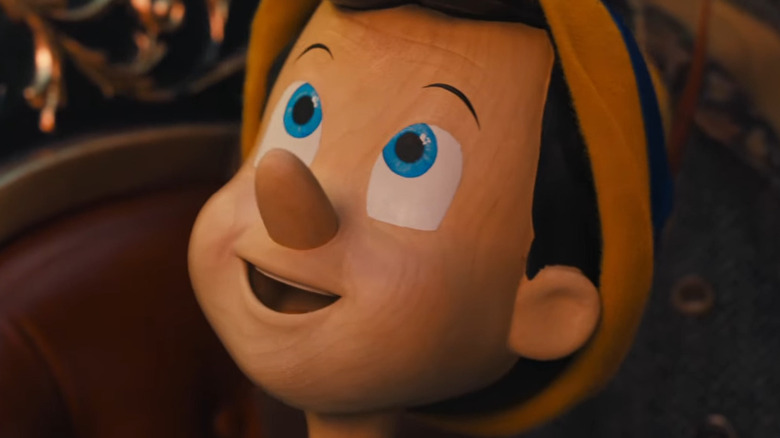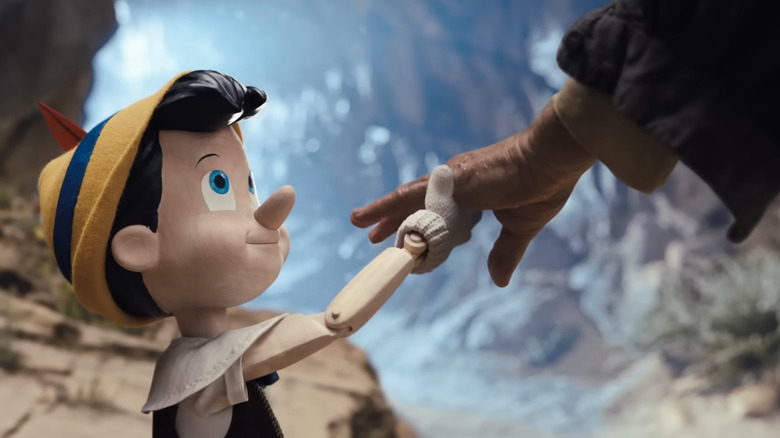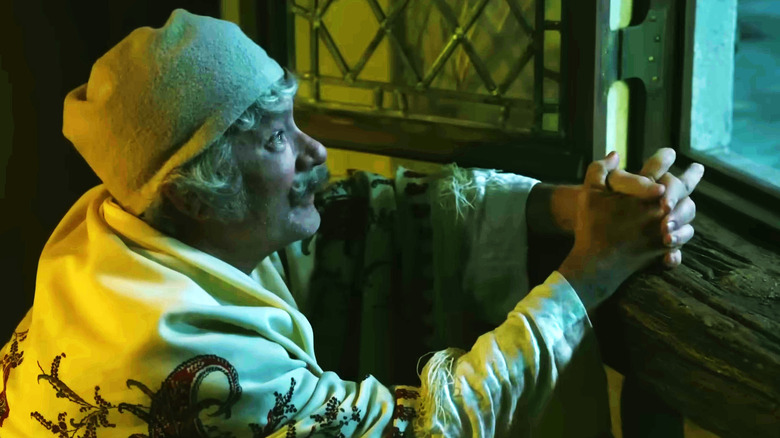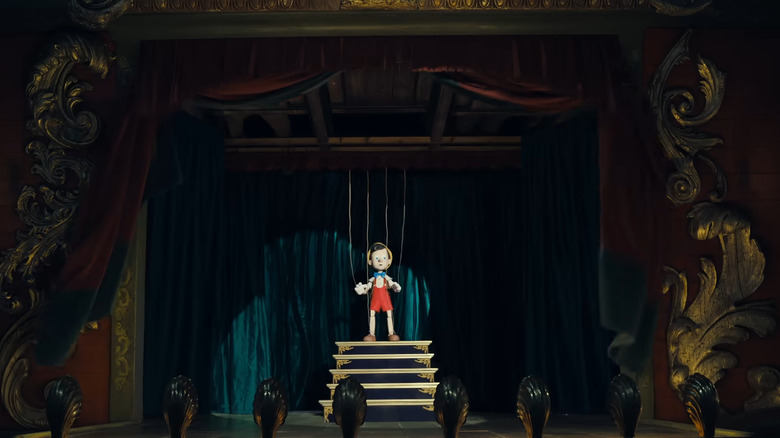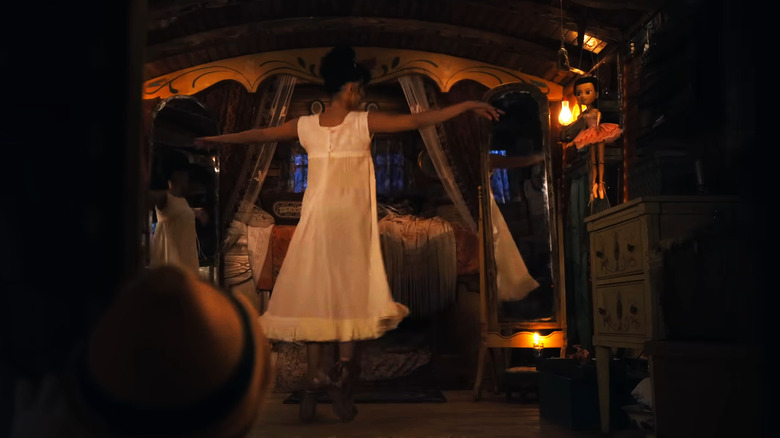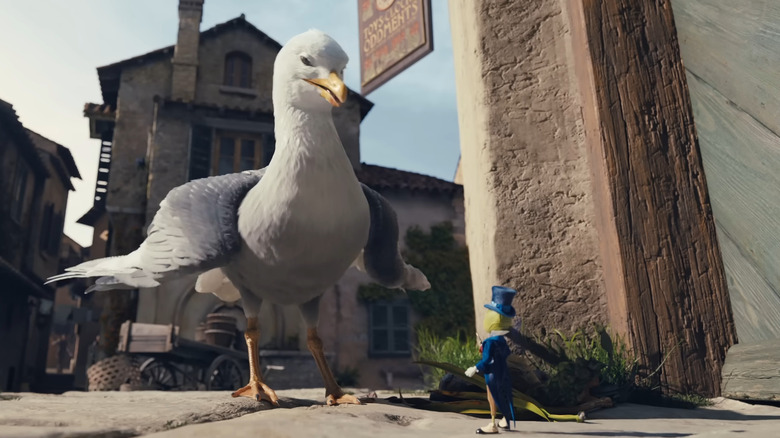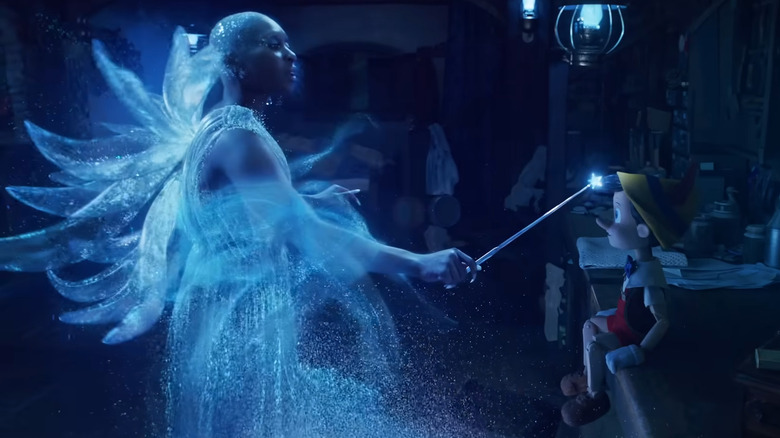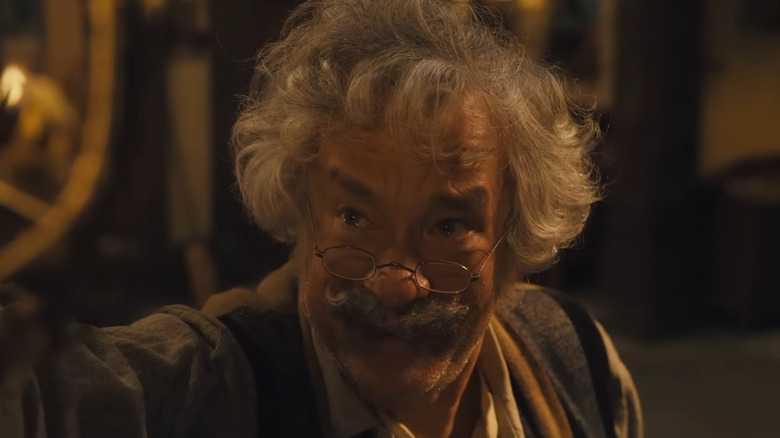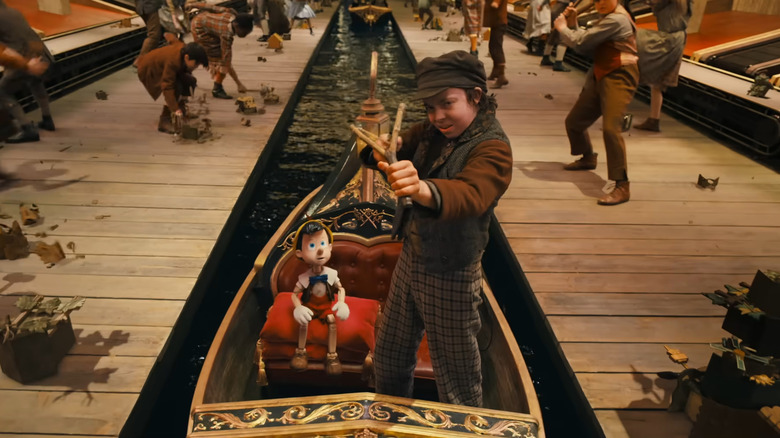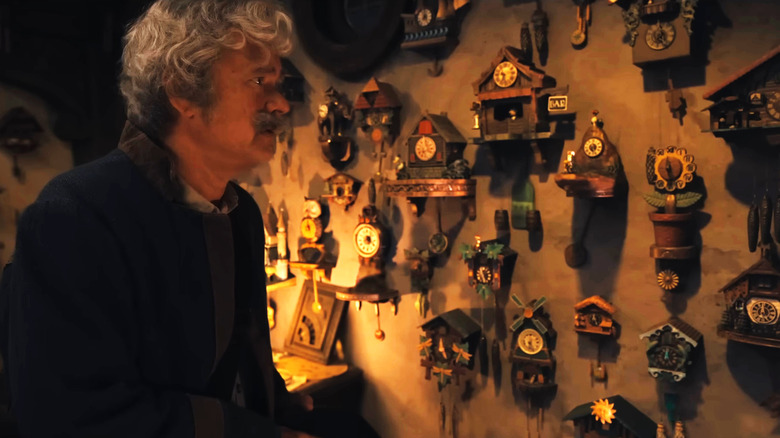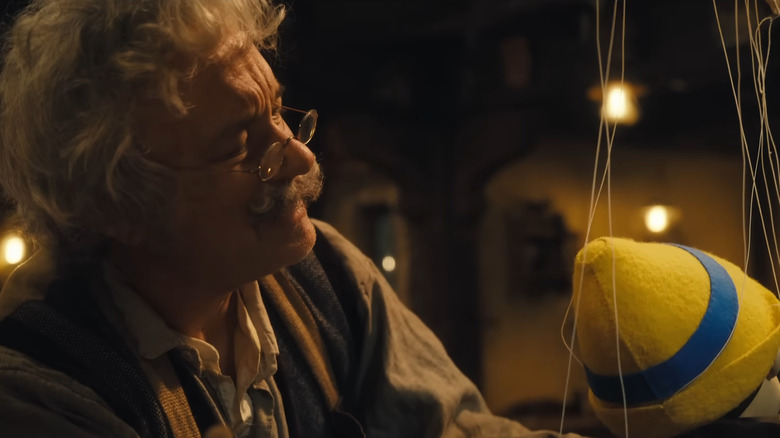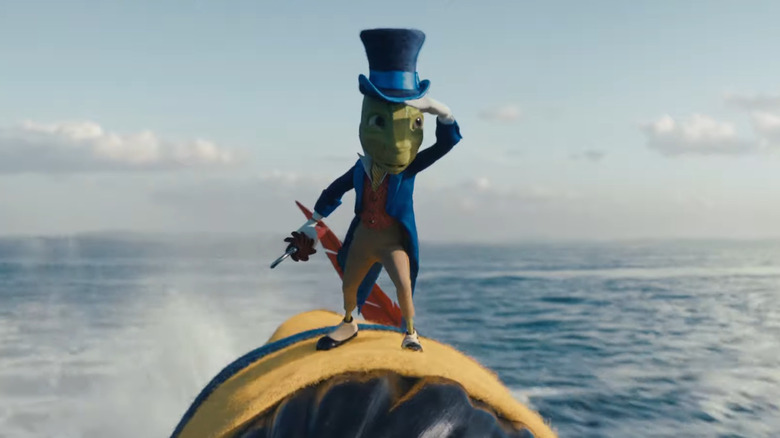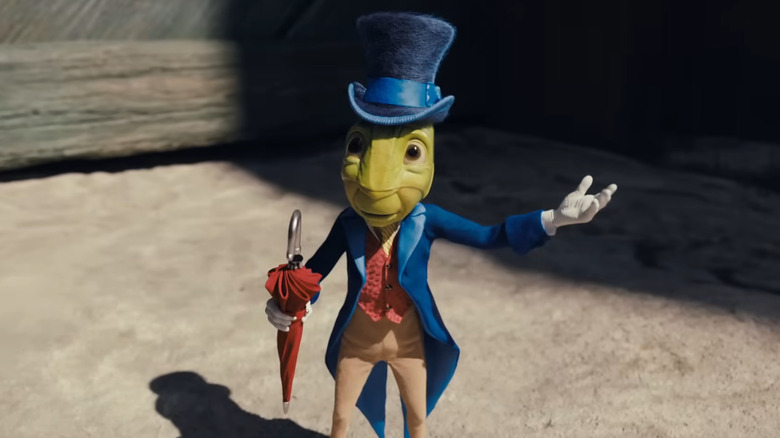The Biggest Differences Between The Pinocchio Remake And The Animated Movie
This article contains spoilers for the 2022 live-action remake of "Pinocchio" on Disney+.
For nearly a century, "Pinocchio" has endured across generations as a shining example of Disney storytelling and the art form of hand-drawn animation. (Even longer than that, "The Adventures of Pinocchio" by Carlo Collodi has endured as a world of literature since 1883.) Debuting in 1940 as only the second film ever produced by Walt Disney Animation Studios — the first being 1937's "Snow White and the Seven Dwarfs" — "Pinocchio" is a timeless fairytale adapted to the screen that exemplifies the power of dreams and the importance of a moral compass.
The 2022 remake of the movie — directed by acclaimed filmmaker Robert Zemeckis — follows a long list of Disney animated classics transformed into live-action remakes. Tom Hanks stars as Geppetto, an elderly craftsman in storybook Italy whose wooden puppet comes to life.
A remake like this has its work cut out for it. Does the reimagining attempt to transcend its source material or celebrate it? Is it only the same story by title, or does it closely follow its predecessor's structure? Are there any necessary adjustments made to account for 80 years of changes in audience expectations? These questions are integral to any adaptation of an existing story, and "Pinocchio" is no exception. The 2022 live-action remake retains the foundation of the 1940 animated film with a few key changes. Let's take a look at some of the biggest differences between the two movies.
Pinocchio's fate is yours to decide
Pinocchio seeks to be "brave, truthful, and unselfish" in both the animated and live-action versions of his story. The Blue Fairy tasks the puppet with mastering those three qualities in order to become a real boy. The final scene in the animated film shows puppet Pinocchio transforming into a human being, having learned to exemplify those character traits. The live-action movie takes a different approach.
The 2022 remake leaves its ending intentionally ambiguous to drive home a new message. Geppetto remarks that Pinocchio's quest to save him embodied everything the Blue Fairy asked the puppet to be. "You will always be my real boy," Geppetto tells his creation. "There isn't a single thing I would change about you. I am so very proud of you and I love you so very much."
Geppetto and Pinocchio begin to make their way home, and as they do, the audience sees Pinocchio visually transform from puppet to human. However, Jiminy Cricket, acting as the story's narrator, is quick to clarify what's happening and speaks directly to the audience. "Since then, many stories have been told about him," Jiminy says of Pinocchio. "People say he was transformed into an honest to goodness real boy. Did that actually happen? Who knows! But I do know one thing for sure: In his heart, Pinocchio is as real as any real boy could ever be."
Geppetto's sad backstory is revealed
In the animated film, Geppetto creates Pinocchio simply because he wants to. While there is earnestness in Geppetto's wish to the wishing star for Pinocchio to become a real boy, any specific reason or backstory leading up to his dream is left to the imagination.
In the remake, Geppetto's history, and therefore his ambition for this venture, is made clear. Geppetto builds Pinocchio as he mourns the loss of his son, whose photograph sits on Geppetto's work desk. The boy seems to have been perhaps around six or seven years old when the photo was taken, making him around the age Pinocchio is when he comes to life.
After Geppetto pleads his wish to the wishing star, the Blue Fairy's magic beams down from the sky, refracts off of the framed photo of Geppetto's son, and bounces onto Pinocchio to give the limp puppet life. Despite this, it's made clear that Pinocchio is not the spirit of Geppetto's son but rather someone new entirely.
The songs get a makeover
The songs from the 1940 animated version of "Pinocchio" have become classic, established tunes in the Disney songbook. Most notably, "When You Wish Upon a Star" won an Oscar and is an anthem for the entire Walt Disney Company, being played instrumentally as part of the logo before every Disney movie.
The remake adapts the original's songs with a few tweaks here and there. Whereas Jiminy Cricket sings "When You Wish Upon a Star" in the animated movie over the opening credits, Cynthia Erivo as the Blue Fairy performs it instead in the live-action remake when she brings Pinocchio to life. "Hi-Diddle-Dee-Dee (An Actor's Life For Me)" is reduced to a few refrains rather than a full song, performed by Keegan Michael-Key as Honest John. "I've Got No Strings" is perhaps the most faithfully duplicated song, remaining in its same placement in the story and being a full production number.
Furthermore, songwriters Alan Silvestri and Glen Ballard add a collection of new songs to the bunch for the remake. Tom Hanks as Geppetto recites the spoken word "When He Was Here with Me" as a substitute for the animated film's "Little Wooden Head" while he crafts Pinocchio. Kyanne Lamaya sings "I Will Always Dance" as her new character, Fabiana, expresses her love for the art of dancing. Lastly, Luke Evans as the Coachman serenades Pinocchio with a song titled "The Coachman to Pleasure Island" while he drives the herd of children to their tantalizingly tempting destination.
Pinocchio's new friend, Fabiana
Kyanne Lamaya plays a new character who wasn't in the animated film altogether: a puppeteer named Fabiana, whose puppet, Sabina, performs alongside Pinocchio in Stromboli's act. In the 1940 film, there are other puppets who join Pinocchio onstage, but the audience only ever sees the puppets themselves, not their offscreen puppeteers. Furthermore, no individual puppets are given names, personalities, or an integral role in the story as Sabina and Fabiana have in the remake.
Pinocchio is distraught as he's held captive in Stromboli's troupe, and Fabiana consoles him — or, rather, Sabina does. Pinocchio is somewhat timid around Fabiana, but he's perfectly comfortable talking to her ballerina puppet, Sabina. Pinocchio seems to either not notice or not care that Fabiana controls Sabina, but all the same Sabina encourages Pinocchio several times throughout the film.
Additionally, Fabiana's inclusion in the remake brings closure to one of the story's villains. In a twist that the audience doesn't get to actually see, Fabiana leads a rebellion against Stromboli and takes over his traveling puppet act. Now she and her fellow puppeteers perform under fair conditions and call their own shots.
Sofia the seagull
Lorraine Bracco voices Sofia the seagull, a new computer-generated character who was absent in the animated movie and befriends both Geppetto and Jiminy Cricket in the 2022 remake. Sofia is streetsmart, knowing the ins and outs of the terrain and the best way to fly from point A to point B. Sofia is apparently a longtime pal of the elderly clockmaker, as she's ecstatic to see him when he emerges from his home in the morning, feeding her scraps. Sofia also helps Jiminy catch up with Pinocchio as he leaves for school. Later in the movie, Sofia aids Geppetto in venturing toward Pleasure Island to find Pinocchio, and in reuniting Pinocchio with Geppetto in the open ocean.
Interestingly, Sofia seems to have different forms of communication depending on who she's talking to. When she speaks with Geppetto, all he hears are squawks and chirps. Jiminy, though, hears coherent sentences spoken in English and incidentally sounds a lot like Bracco.
The Blue Fairy only appears once
The Blue Fairy grants Geppetto's wish and gives life to Pinocchio. In the 1940 version of the story, the Blue Fairy has a repeated presence throughout the movie. She not only appears toward the beginning of the film in Geppetto's workshop but also returns to help Pinocchio escape from Stromboli's clutches. In the 2022 remake, in which Cynthia Erivo plays the iconic character, the Blue Fairy's first and only onscreen appearance is when she visits Geppetto's home to bring Pinocchio to life. Later, Pinocchio finds a clever way to bust out of Stromboli's carriage himself without requiring the Blue Fairy's assistance. The finale of the film, which sees Pinocchio's tears reviving a dead Geppetto and a radiant blue light guiding the pair's way home, implies that the Blue Fairy may still be helping the heroes from afar, even if she's not physically present.
Furthermore, the idea of Jiminy Cricket proving himself as worthy of the Blue Fairy's approval is dropped in the remake. In addition to showing Pinocchio wanting to become a real boy, the animated film sees Jiminy striving the entire movie to become Pinocchio's "official conscience," and the Blue Fairy ultimately grants him this distinction, complete with a shiny medallion.
Geppetto almost dies
The climax of both the animated and live-action versions of "Pinocchio" brings our hero face-to-face with Monstro the sea beast. Pinocchio and Geppetto put up a valiant effort against the colossal creature and ultimately escape. In each version, one of the two of them appears to not have survived the encounter, but the different variations flip-flop which one of them is at death's doorstep.
In the animated movie, Pinocchio appears unconscious following the battle with Monstro. Geppetto woefully carries him back home, where the Blue Fairy's magic revives Pinocchio and transforms him into a real boy. In the live-action remake, it's Geppetto who is seemingly dead after fighting Monstro. Pinocchio cries over his father's body, his tears apparently having magical properties that bring Geppetto back to life. (This is not unlike Rapunzel, another Disney hero with healing tears.) The real miracle, though, is how they managed to get through an entire ocean battle while keeping their goldfish in her fishbowl.
Pleasure Island in all its glory
Pleasure Island is the ultimate catfish. It's a place that promises glee and enjoyment to its visitors, but secretly the whole destination is a front for creating laborer donkeys from its children patrons. Big yikes. The moral within the context of the "Pinocchio" story is to not give into all of life's pleasures, or else — with a terrifyingly visual moral that no doubt has scarred countless childhoods over the years.
In the 1940 film, Honest John is in cahoots with the Coachman and swindles Pinocchio into going to Pleasure Island. Furthermore, while filmmakers briefly show an exterior wide shot of Pleasure Island, the location isn't really shown all that much. It's mostly reduced to an indoor scene taking place in a nondescript room where Pinocchio and his new pal Lampwick play pool and eventually become donkeys.
In the 2022 remake, Honest John has no connection to the Coachman. Instead, the Coachman merely swipes Pinocchio from off of a street corner as he passes by. The audience then very much sees the extent of Pleasure Island's many delights, from amusement park rides to unlimited root beer. The remake also includes girls in the Pleasure Island con, whereas the animated film only recruits boys.
The meanings behind Geppetto's clocks
Geppetto is a clockmaker in both the 1940 and 2022 versions of "Pinocchio," though, in the former, his purpose for clockmaking is never mentioned. In the remake, it's explained that Geppetto's late wife loved his clocks, and he continues making them in her honor. In fact, he refuses to part with any of them, much to the dismay of prospective customers. He finally sells his entire collection as a means to help find Pinocchio when the puppet gets kidnapped to Pleasure Island.
Incidentally, the cuckoo clocks in the remake have more than just an emotional connection to Geppetto. The clocks — intricate in design and depicting vignettes with movable figures — emulate famous Disney movies, some with personal connections to the cast and crew of "Pinocchio." One clock shows Woody from "Toy Story" riding his horse, Bullseye, a clear tribute to Tom Hanks, who voices the iconic Pixar cowboy and plays Geppetto in live-action. Another shows Roger and Jessica Rabbit from "Who Framed Roger Rabbit," a movie directed by Robert Zemeckis, who also helms "Pinocchio." Other clocks might not have specific ties to "Pinocchio" filmmakers, but effectively round out the Disney canon, depicting famous moments from "Sleeping Beauty," "The Lion King," and others.
Pinocchio's name explained
In the original movie, Geppetto simply names his puppet "Pinocchio" without explanation. While viewers who really think about it may be able to put two and two together, in the remake Geppetto fully explains his reasoning out loud, just to make sure everyone is on the same page.
While Pinocchio is still inanimate, Geppetto speaks to his creation as if he's alive all the same. "I carved you out of wood," he says. "I made you out of pine." Thus, he dubs "Pinocchio" as the perfect name for his creation.
For as blatant as the film explains the name, there's still more to discover that it leaves out. A bit of research yields a double entendre play on words through translation that may not have been author Carlo Collodi's intention when naming the character in the 1800s, but fits within the new script regardless. In Italian, the suffix "-occhio" means "eye." So while "Pinocchio" literally translates to "eye of pine" or "pine eye," a looser translation means exactly what Geppetto spoke: "I made you out of pine."
Pinocchio actually goes to school... for a hot minute
In the animated film, Geppetto sends Pinocchio off to school the very first morning after the puppet comes to life. Inevitably, Honest John and Gideon intercept Pinocchio on his walk and recruit him to join Stromboli's acting troupe. Pinocchio never makes it to the schoolhouse.
Things go a little differently in the live-action remake. For starters, more time seems to have passed in between Pinocchio coming to life and Geppetto sending him to school. A brief montage indicates that at least a few days transpire with Geppetto always being by Pinocchio's side, but still in Geppetto's home. When Geppetto eventually bids Pinocchio farewell with instructions to walk to school solo, Pinocchio still encounters Honest John and Gideon along the way. However, in a change, he holds his own, resists their pressure, and makes it to school. The end result, though, doesn't make too much of a difference, as the schoolteacher immediately dismisses Pinocchio because he's a puppet, and Pinnoke goes along with Honest John all the same.
It's anyone's guess as to why, in both versions, Geppetto would assume Pinocchio would successfully achieve anything on his own, given that this is the puppet's first time outside the house, ever.
Trekking across the ocean
Monstro the sea beast poses a dangerous threat to Pinocchio and Geppetto in both the animated and live-action versions of the story, but how the characters reach him and the chronology of narrative events are slightly different in each movie. The original 1940 film sees Geppetto already swallowed by Monstro before Pinocchio finds him. To reach his father, Pinocchio travels with Jiminy Cricket underwater on the ocean floor, encountering various undersea creatures in the process. The 2022 remake has Pinocchio enlisting the help of Sofia the seagull, a new character, to find Geppetto. Sofia flies in the air and carries a rope in her mouth as she glides over the ocean, which Pinocchio hangs onto to form a makeshift jet ski. He reunites with Geppetto while Geppetto is still on the surface of the water, and Monstro swallows both of them together just as they reach each other.
In another slight difference around this part of the story, Pinocchio's donkey ears and tail from Pleasure Island stay with him for the duration of the animated movie until he becomes a real boy at the end. In the remake, the ears and tail disappear as Pinocchio demonstrates bravery, truthfulness, and unselfishness in beginning his quest to rescue Geppetto.
Jiminy Cricket makes cricket noises
2022's "Pinocchio" is still very much a fairytale, but as with most live-action adaptations of animated films, it tweaks its aesthetic here and there to depict a world that feels more realistic than its animated counterpart — even within its decidedly fantastical context of fairies, magic, living puppets, and talking animals.
One such attempt at realism comes from Jiminy Cricket emitting a small chirp every now and then as he walks about, something the 1940 version of the character doesn't do. While the 2022 adaptation of "Pinocchio" is mostly live-action, Jiminy himself is computer-animated, and voiced by Joseph Gordon-Levitt — who returns to Disney 20 years after voicing Jim Hawkins in "Treasure Planet." Despite Jiminy's excessive chirping as he follows Pinocchio around and tries to keep him out of trouble, the cricket still never catches the attention of Geppetto. As with the original, Pinocchio interacts directly with Jiminy, but Geppetto never does.
